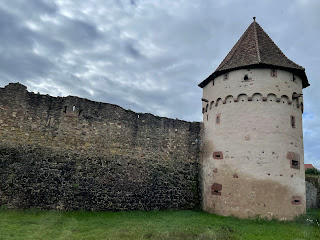We had purchased in advance a day tour of Alsace villages and countryside. We thought, when we bought it online, that the pickup point would be the Gare Centrale, just across the street from our hotel. It turned out to be a different Gare, about a half-hour's walk. But we discovered this the day before, so we still arrived early, after a better than expected breakfast at the hotel.
Alsace, as a crossroads of Europe, has been a place of conflict since Roman times. Trade routes from France and the Low Countries into Switzerland and Germany must run through this region because of the Vosges Mountains cutting off access to the Rhine River by any other route. Also, the plains of Alsace are some of the most fertile land in all of Europe, so the land itself is of high value.
In ancient and Medieval times, that meant the necessity of fortifications. There was an abundance of castles in this region. Most are now in ruins, but Haut-Koenigsbourg was faithfully restored near the beginning of the 20th century and is open to tourists for the price of a ticket. That ticket was included in our tour, and we had about 90 minutes to explore it.
The castle's foundation is a stone outcrop well up the mountainside, with an excellent view of both the "wine road" and the "wheat road" crossing Alsace. We think of castles as busy places, but except in times when surrounding villagers sought refuge, there were seldom more than a couple dozen inhabitants of the entire structure, and only about half of those where actual soldiers.
We had opportunity to drive slowly through several very scenic villages, including Kintzheim, Bergheim, Ribeauville, and Hunawihr. Most of these places date back at least to the 9th or 10th centuries, although most were destroyed in the 1630s when Gustavus Adolphus moved through Alsace during the 30 Years War. One still sees buildings with cornerstones carved with dates in the 1630s or 1640s.
Hunawihr featured a rather odd church that had a fortified wall around it. It was both a house of worship and a fortress! The Catholic cemetery was inside the wall, but Protestants had to be buried outside.
Some of the villages were almost completely demolished when the Americans liberated them in 1944 and 1945. We drove by a French military cemetery near the villages of Sigolsheim and Kientzheim on a mountain known since World War II as "the hill of blood."
Our second stop was the very scenic village of Riquewhir, where we had lunch and a glass of local wine. Like many of these villages, some portions of the old city walls remain intact, even after multiple wars.
Third stop of the day was Kaysersberg, where we also had a small wine tasting and had a chance to see the house where Albert Schweitzer was born. Shopkeepers in Kaysersberg were very generous with free samples of their cheese and baked goods!
Kaysersberg also had a very beautiful little church that demonstrated its wealth with a fabulous altar piece. We weren't able to find out much about it, but it was quite spectacular.
We ended the day in the city of Colmar, the second city of Alsace, behind Strasbourg. Our tour included a ride around the city center on a tourist "train." We were getting rather tired by this time, having walked a good deal. So we really didn't mind the hokey ride. But we also didn't really feel as though we got the feel of the city.
We had enough extra time to eat a light supper at a Colmar bakery, however. And we were extremely fortunate with weather. The forecast was for rain, and it did -- sometimes pretty hard. But every time it rained we were either in the van or in a building. So except for a few sprinkles, we never got wet. We never even used our umbrellas.












No comments:
Post a Comment